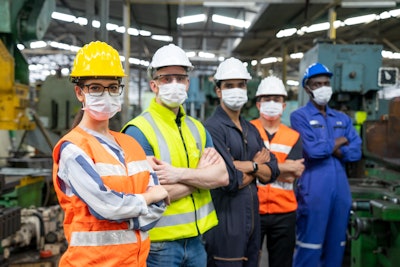
Walk into a classroom today and ask a group of Gen Z students what careers excite them, and you’ll hear answers like software developer, entrepreneur, or social media creator. What you’re unlikely to hear is “manufacturing engineer” or “supply chain manager.” And that should concern all of us.
However, the “next wave” of AI is showing great potential and should be of interest to Gen Z.
This renewed emphasis on hardware and the physical sciences underscores a critical gap in the innovation pipeline: the manufacturing talent deficit.
Manufacturing is the backbone of innovation, yet we’re facing a generational talent gap. A Deloitte and Manufacturing Institute study warns that by 2030, up to 2.1 million manufacturing jobs in the United States could go unfilled if the trend continues, costing the economy as much as $1 trillion in 2030 alone.
The supply chain industry can’t afford to let that happen. So why is Gen Z overlooking manufacturing, and what can employers do to reverse the trend?
The perception gap
For many young people, manufacturing still conjures images of repetitive, low-tech factory work. This outdated stereotype ignores the reality of advanced manufacturing, which is increasingly defined by automation, robotics, AI-driven design, and advanced materials.
Today’s factories look more like tech labs than industrial assembly lines. In aerospace, additive manufacturing is producing complex, lightweight parts that were impossible to build a decade ago. In MedTech, precision machining and molding are enabling life-saving devices. Yet this story hasn’t been told well enough.
A recent Business Insider report found that companies are already struggling to fill hundreds of thousands of manufacturing positions, even before factoring in the long-term skills gap. The problem isn’t just lack of talent—it’s lack of awareness.
Lack of visibility
Manufacturing suffers from a branding problem. Unlike careers in finance, tech, or healthcare, it’s not prominently featured in popular culture. Gen Z grew up watching tech entrepreneurs become household names. They scroll social media platforms and see content creators making careers out of personal brands. But they don’t see manufacturing engineers designing the systems that make everything from sneakers to satellites possible.
This lack of visibility creates a self-perpetuating cycle: because students don’t see role models in manufacturing, they don’t consider it a viable or aspirational career path.
True partnerships
What helps: Partnering with universities and trade schools to showcase real innovation. Sometimes, it’s as simple as showing up, meeting young people face to face, and sharing what you’re working on. They may not know what today’s manufacturing is really like or how it’s changed, and despite the panic about the skills gap, many manufacturers aren’t taking the time to just show them.
What Gen Z values
Gen Z, those born between 1997-2012, is the most diverse, connected, and socially conscious generation in many years. According to McKinsey, they are motivated less by pure compensation than by career development opportunities, flexibility, meaningful work, and supportive leadership.
Another survey from the Times of India notes that Gen Z has outgrown the “dream job” fantasy—they’re looking for stability, work-life balance, and values alignment over prestige titles.
Unfortunately, manufacturing hasn’t positioned itself to meet these expectations. The perception remains that jobs are rigid, location-bound, and lacking in career growth. The reality, however, is much different—manufacturing is rapidly evolving into a tech-driven industry that checks many of the boxes Gen Z says it wants.
Green manufacturing and cleantech resonate with the next generation’s focus on meaningful work and environmental impact (90% of Gen Z and Millennials believe it’s essential that their work reflects these values).
The challenge is in telling that story effectively.
What employers can do to change the trajectory
Modernize the narrative
Employers need to actively rebrand manufacturing as a high-tech, purpose-driven industry. Highlight automation, AI, sustainability, and innovation. Showcase real examples of how manufacturing contributes to clean energy, medical breakthroughs, and national security.
A student who wants to work on climate change may not realize that a career in advanced materials manufacturing is directly aligned with those goals.
Meet Gen Z where they are
Gen Z lives online. They consume career inspiration not from job fairs, but from social media. Manufacturers need to show up there too, with authentic storytelling. Highlight young engineers and machinists explaining how they solved real-world problems. Use short-form video to show drones or AI optimizing designs.
By reframing manufacturing as an exciting, future-facing career, employers can start to change perceptions.
Invest in growth and purpose
Gen Z doesn’t just want a job—they want a career path. Apprenticeships, micro-credentials, and ongoing training programs are crucial. Employers should highlight how someone can start as a technician and grow into a plant manager, or how design engineers can expand into leadership roles.
Equally important is purpose. Manufacturing companies must connect the dots between their work and the broader world. Whether it’s producing renewable energy equipment or life-saving medical devices, or electric vehicles, young talent wants to know their work matters.
Redefine pathways
Not every Gen Z worker will pursue a four-year engineering degree, nor should they have to. Employers must expand partnerships with community colleges, vocational schools, and bootcamps to create multiple entry points into the field.
Apprenticeship models, already successful in Europe, are underutilized in the United States. Building more accessible pathways helps break down barriers and makes the field more inclusive.
Some companies are already moving in the right direction. Initiatives are designed to attract new generations by spotlighting innovation and career opportunities. The stated mission is to close the skills gap through these efforts. Other companies are using AR and VR to bring factory tours into classrooms, allowing students to see how manufacturing blends creativity with cutting-edge technology.
AI is already helping engineers make smarter material choices. Robotics and automation are redefining how products are made. And global digital supply chains are making it possible to bring ideas to life at unprecedented speed.
But unless we can help Gen Z see this, we risk losing an entire generation of talent to other industries. The challenge isn’t whether opportunity exists—it’s whether we’re telling the story in a way that resonates.
Closing thoughts
Manufacturing has always been about solving hard problems—how to build more efficiently, how to make products safer, how to design for scale. Those are exactly the kinds of challenges that appeal to Gen Z’s curiosity and drive for impact.
The task ahead is clear: reframe manufacturing not as yesterday’s industry, but as tomorrow’s frontier. If we succeed, we’ll not only close the skills gap—we’ll unlock a new generation of creators ready to build the future.
Because when Gen Z discovers manufacturing, they won’t just see jobs. They’ll see careers that matter, work that shapes the world, and the chance to be part of something bigger than themselves.




















